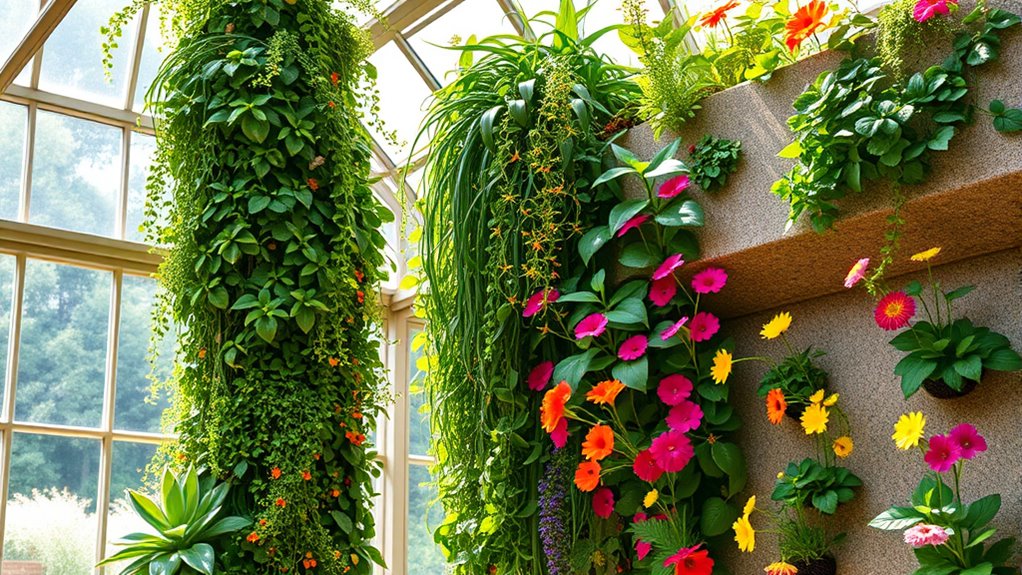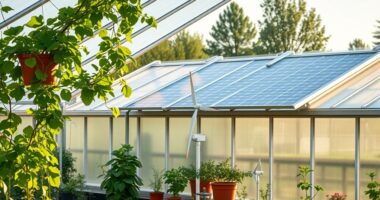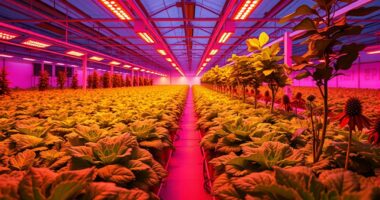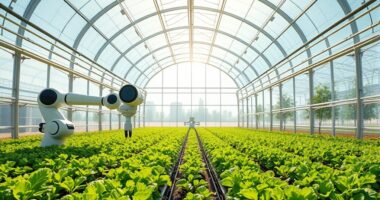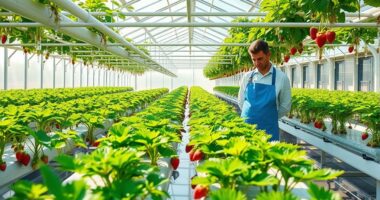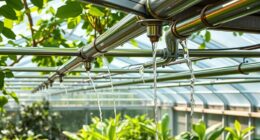Vertical gardening in a greenhouse setting lets you maximize your space and grow a variety of plants efficiently. This innovative method increases your crop yield while improving air circulation and reducing pest risks. You can choose from different systems, like hydroponics or soil-based setups, to suit your needs. Plus, it's not just beneficial for you; it enhances urban biodiversity and reduces noise. Keep exploring to discover even more advantages and tips to optimize your greenhouse garden.
Key Takeaways
- Vertical gardening in greenhouses maximizes space and increases crop yield by utilizing vertical structures for plant growth.
- Improved air circulation in vertical gardens reduces the risk of mold and pests, ensuring healthier plants.
- Hydroponic systems in vertical gardens enhance water efficiency, promoting sustainable practices while conserving resources.
- Year-round production of diverse crops is achievable in greenhouses with vertical gardening, making it suitable for various climates.
- Vertical gardening supports biodiversity, providing habitats for beneficial insects and promoting a balanced ecosystem in urban environments.
Defining Vertical Gardening
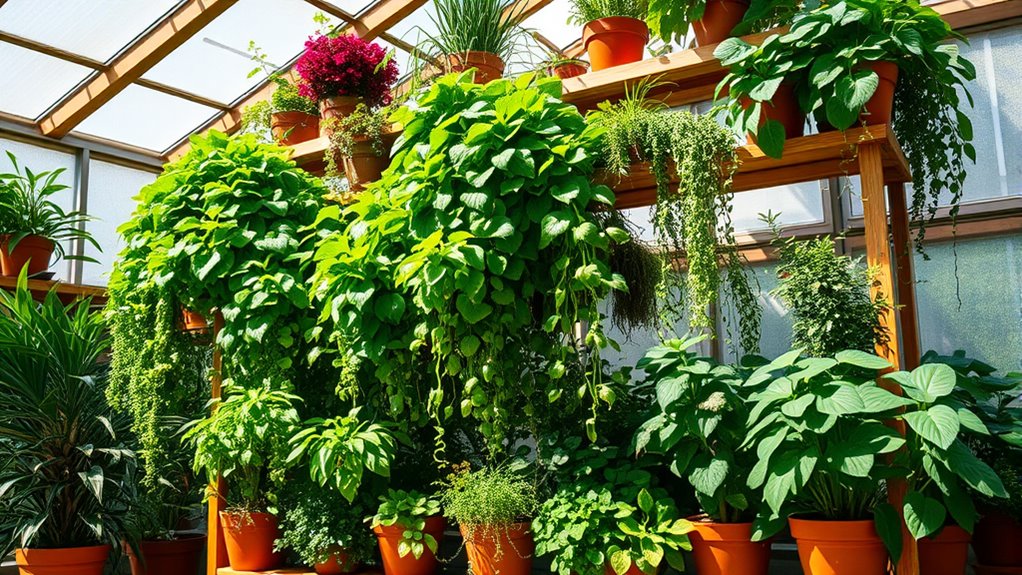
Vertical gardening is an innovative approach that transforms the way you grow plants by utilizing vertical space instead of traditional horizontal layouts. This method maximizes your available space by stacking plants one on top of another, making it ideal for small areas.
You can use various structures like shelving, vertical planters, and hydroponic systems to create your garden. Both soil-based and hydroponic growth methods are effective in vertical gardens, allowing for flexibility in how you cultivate. Additionally, vertical gardening adapts well to different environments, whether in a greenhouse or an urban setting. By employing systems like trellises or hanging pots, you can optimize your gardening experience while enjoying a diverse range of plants. This practice can significantly increase crop yield while using a smaller land area compared to traditional gardening methods.
Benefits of Vertical Gardening in Greenhouses
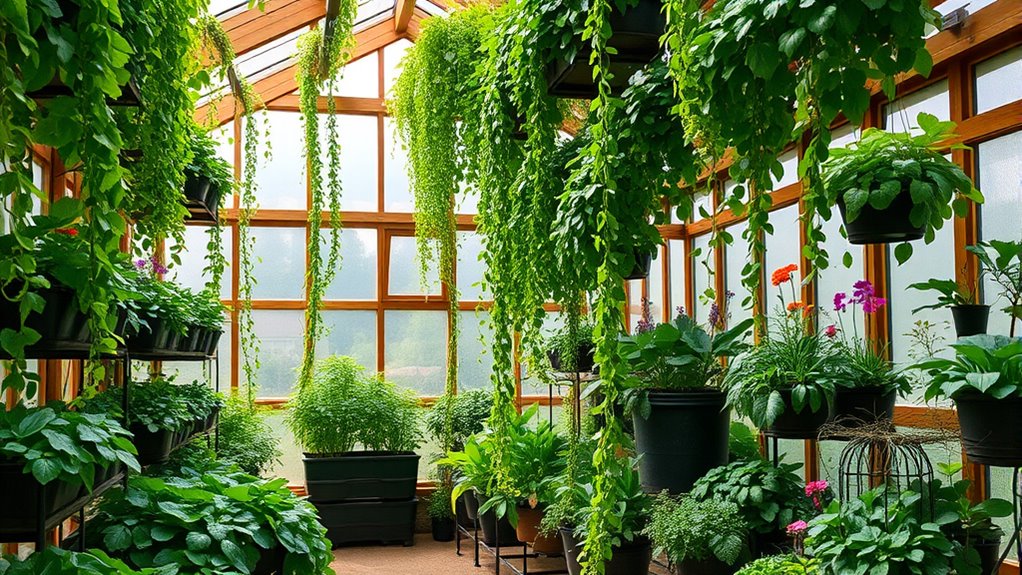
When you embrace vertical gardening in a greenhouse, you unlock a myriad of benefits that enhance both productivity and plant health. You can significantly increase your growing capacity by utilizing vertical space, effectively doubling or tripling your plant output without expanding your footprint. This method improves air circulation, reducing the risk of mold and pests, while also enabling healthier growth conditions. With vertical setups, you'll find maintenance easier, allowing for efficient watering and harvesting. Plus, you can enjoy year-round production of diverse crops. By optimizing resource use, you'll conserve water and energy, making your greenhouse more sustainable. Ultimately, vertical gardening not only boosts yields but also adds aesthetic value to your greenhouse space. Vertical gardening maximizes greenhouse potential by growing plants upwards.
Different Types of Vertical Gardening Systems
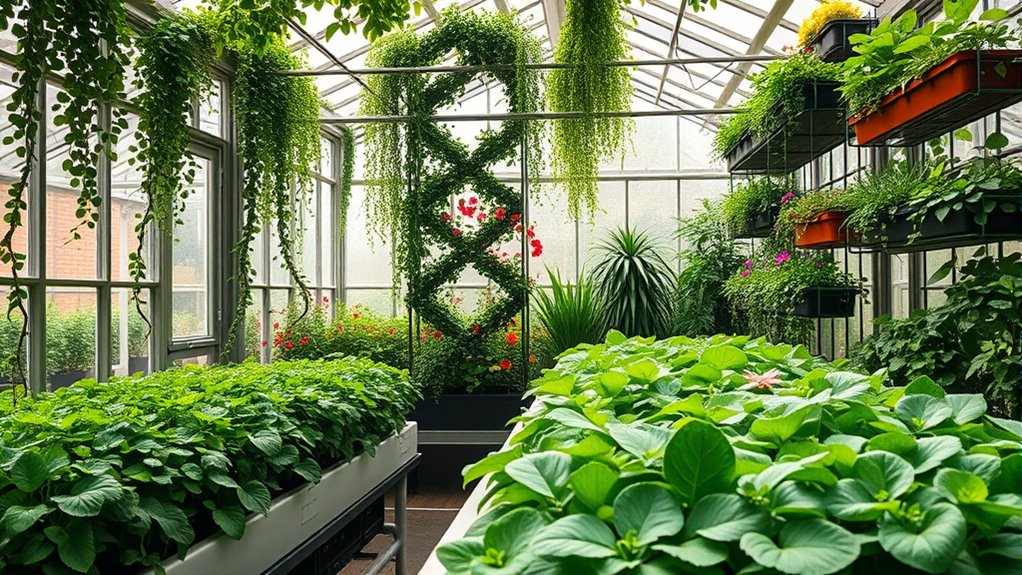
Embracing vertical gardening opens up a variety of systems that cater to different needs and preferences. Hydroponic systems let you grow plants in nutrient-rich water, while soil-based systems use traditional soil or compost. For example, green walls often utilize hydroponic systems for efficient space management and plant growth. For flexibility, consider combination systems that blend both methods. Vertical wall pots offer modular planting pockets, and trellis systems provide vertical support for climbing plants like tomatoes. You can maximize floor space with shelving systems or vertical planters designed for easy access. Hanging baskets allow for air-grown plants, while support structures like stainless steel cables and trellises ensure stability. Technologies like aeroponics and automated systems make gardening even more efficient, enabling you to cultivate a thriving vertical garden in your greenhouse.
Ideal Plants for Vertical Gardening
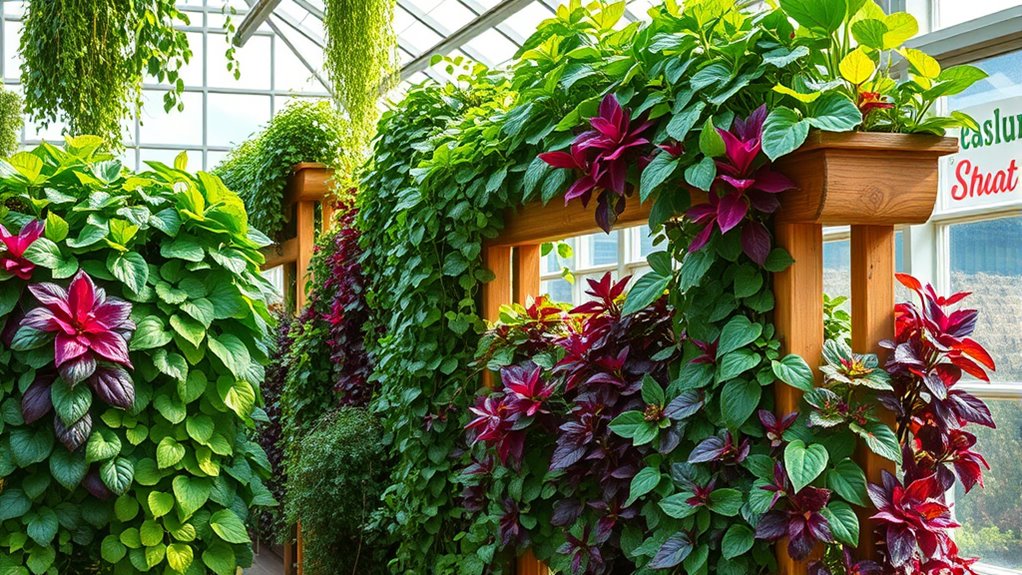
Choosing the right plants is crucial for a successful vertical garden in your greenhouse. For climbing plants, consider cucumbers, pole beans, and snap peas, as they naturally ascend and thrive with support. Smaller squash varieties and melons can also be grown vertically using trellises or hammocks. Additionally, vertical gardening allows for enhanced air circulation, which can reduce pests and diseases among your crops.
For leafy greens, lettuce, spinach, and kale are perfect due to their compact growth. Herbs like basil and mint adapt well to vertical setups too. If you're looking for small fruiting plants, indeterminate tomatoes, peppers, and strawberries work well in containers. Lastly, add visual appeal with flowers such as petunias and nasturtiums, which also deter pests.
Setting Up Your Vertical Garden
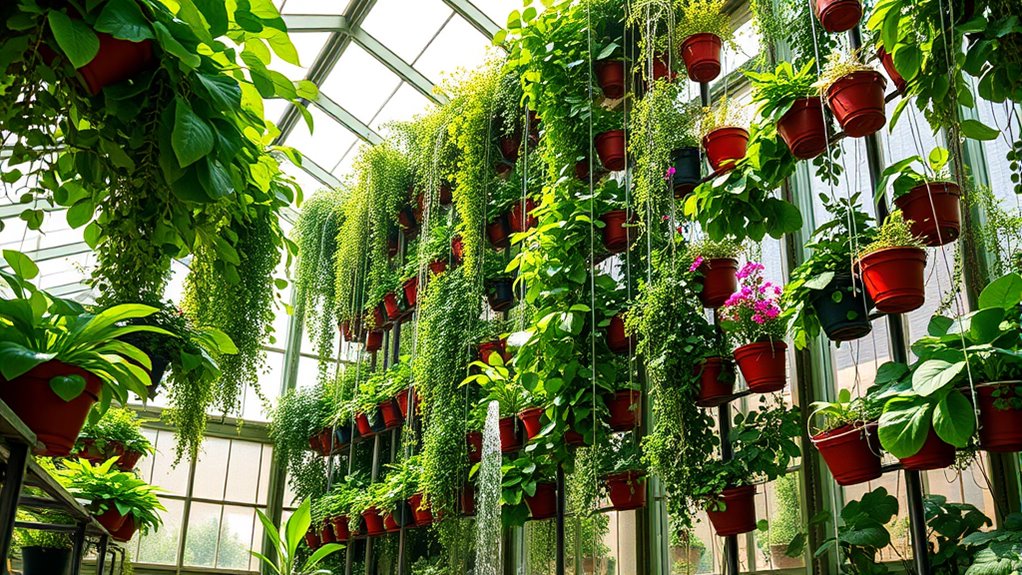
To successfully set up your vertical garden, you need to prioritize structural support and layout. Securely position your vertical structures within the greenhouse to prevent tipping, and ensure they're balanced to provide adequate sunlight to all plants.
Place taller structures at the back or sides to maximize light exposure. Consider the extra weight of plants and soil, and use safety supports if necessary. Implement a drip irrigation system for consistent moisture, adjusting watering based on plant type. Regularly prune to control growth and enhance fruit production. Additionally, consider incorporating self-watering planters to reduce maintenance and ensure optimal hydration, as they help maintain ideal moisture levels for your plants.
Lastly, promote air circulation to prevent mold and pests, and consider adding ventilation systems to maintain a healthy environment for your plants. Improved air circulation can also help reduce the risk of fungal diseases and airborne pathogens in your vertical garden.
Maximizing Space and Efficiency in Greenhouses
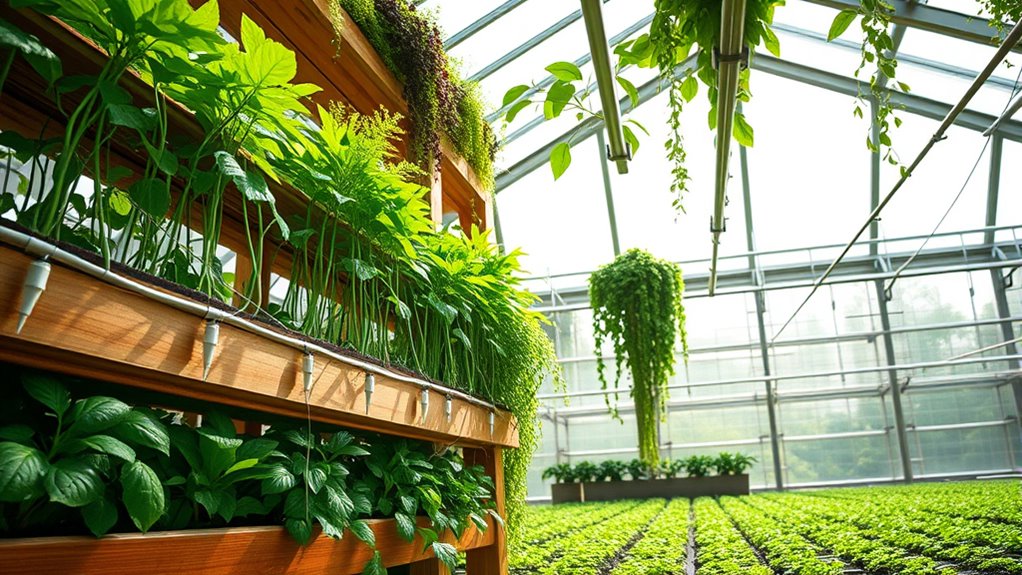
When maximizing space and efficiency in your greenhouse, strategic planning is essential.
Utilize shelving units to stack potted plants vertically, ensuring easy access and optimal light exposure. Incorporate trellises for vining plants like cucumbers, freeing up valuable ground space. Hanging baskets can create additional layers for herbs and compact vegetables. Consider using grow towers or vertical hydroponic systems to increase crop yields while conserving space. Proper plant spacing enhances air circulation, reducing disease risks, while ventilation systems maintain humidity control. Additionally, incorporating vertical farming approaches can optimize production and make the most of limited greenhouse space. Implementing sustainable practices can further enhance the efficiency of your greenhouse setup. Utilize reflective surfaces to boost natural light and monitor airflow regularly. By organizing your layout effectively, you can simplify maintenance tasks, improve accessibility, and create a thriving, productive greenhouse environment.
Maintaining Your Vertical Garden
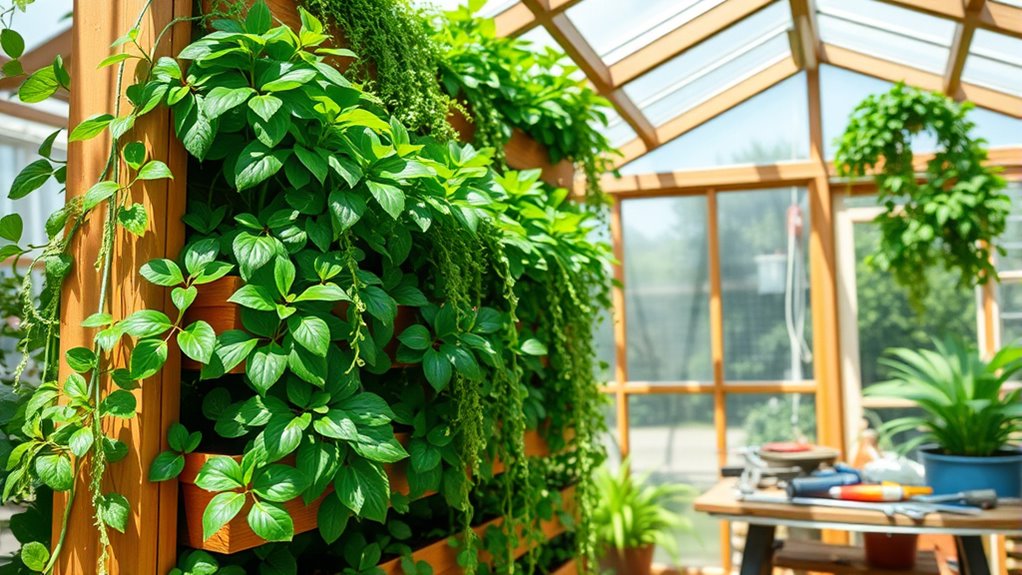
Maintaining your vertical garden requires attention to several key practices that ensure healthy growth and productivity.
Start by monitoring soil moisture levels regularly, adjusting your watering schedule based on your climate. Use drip emitters for even distribution and check for clogs bi-weekly. Additionally, consider implementing automated irrigation systems for consistent hydration and ease of maintenance.
Don't forget to prune and trim dead leaves and overgrown sections to maintain aesthetics and promote balanced light. For fertilization, choose organic options and avoid overfertilizing to prevent salt buildup.
Regularly inspect your plants for pests or diseases, using integrated pest management strategies to keep them at bay.
Finally, prepare for seasonal changes by adjusting care routines, ensuring your plants thrive year-round.
With these practices, you'll enjoy a flourishing vertical garden.
Environmental Impact of Vertical Gardening
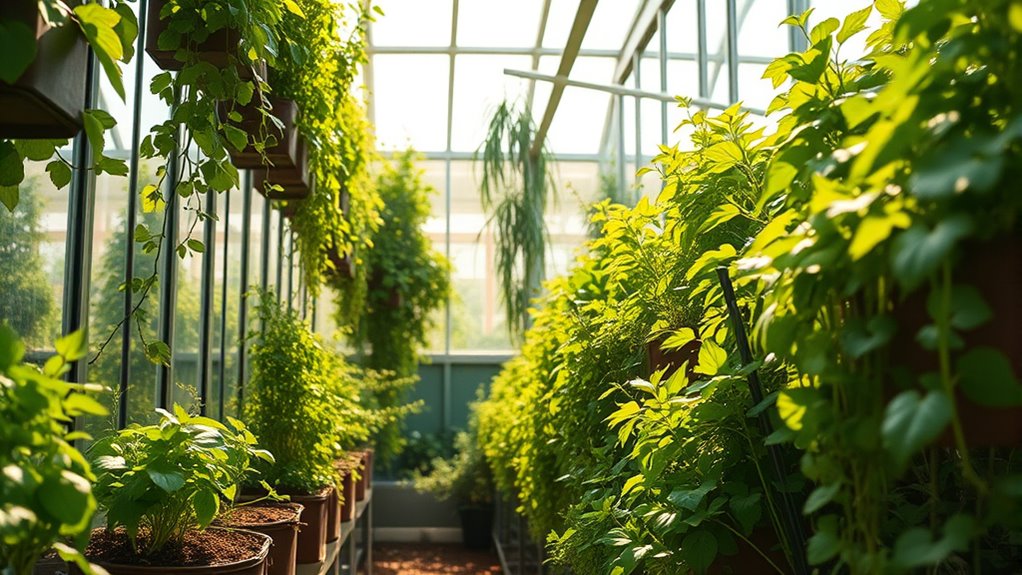
Vertical gardening offers a range of environmental benefits that can significantly enhance urban spaces. By acting as carbon sinks, these gardens help absorb and store carbon from the atmosphere, improving air quality by filtering out pollutants. They also promote biodiversity, providing habitats for insects and birds. You'll appreciate the water conservation that comes with delivering moisture directly to plant roots, minimizing waste. Additionally, vertical gardens serve as natural sound barriers, reducing noise pollution. By optimizing space and reducing land use, they preserve natural habitats. With advanced hydroponic systems, water use is efficient, while growing food closer to urban centers cuts transportation emissions. Embracing vertical gardening can truly transform your environment for the better, as it contributes to increased green cover in urban areas.
Frequently Asked Questions
How Much Initial Investment Is Needed for Vertical Gardening?
When you're considering vertical gardening, your initial investment can vary significantly.
You'll need to account for construction costs, specialized equipment, and land preparation. Don't forget about utility installations and materials for the structure.
Depending on your choices, you might spend anywhere from a few thousand to tens of thousands.
To get a clear picture, conduct a thorough ROI and cost-benefit analysis to ensure it's a financially sound decision.
Can Vertical Gardens Be Moved Easily Within the Greenhouse?
Ever wondered if you can easily rearrange your vertical garden? Yes, you can!
Vertical gardens often use lightweight materials and modular systems, making them simple to move. You'll find adjustable shelving and trellis systems designed for flexibility.
However, ensure you maintain structural stability and even weight distribution when relocating. By considering air circulation and accessibility, you'll maximize your space and keep your plants thriving in their new spots.
What Are Common Pests Affecting Vertical Gardens?
Common pests affecting your garden include whiteflies, thrips, spider mites, fungus gnats, and shore flies.
Each of these pests can damage your plants, leading to reduced growth and vigor.
To keep your garden thriving, monitor for signs of infestation regularly.
If you notice any pests, act quickly to manage them using integrated pest management strategies, including biological controls and maintaining a clean environment.
This'll help ensure your plants stay healthy and productive.
How Do I Choose the Right Vertical Gardening System for My Space?
Did you know that vertical gardening can increase crop yields by up to 30%?
To choose the right vertical gardening system for your space, first assess your available area and budget.
Consider scalability and flexibility for future needs.
Select a system that can support the weight of your chosen plants and ensure it's durable enough for your environment.
Finally, think about incorporating technology for optimal growth conditions and resource efficiency.
Are There Specific Tools Needed for Vertical Gardening Maintenance?
For effective vertical gardening maintenance, you'll need a few essential tools.
Pruning shears will help you trim plants for even growth, while watering cans ensure your plants get the moisture they need.
A pH tester is crucial for monitoring soil health, and a soil thermometer helps maintain optimal temperatures.
Additionally, consider using rakes for soil leveling.
With these tools, you'll keep your vertical garden thriving and healthy all season long.
Conclusion
As you stand amidst your thriving vertical garden, the lush greens cascade like a living tapestry, each plant telling its own story. You've transformed your greenhouse into a vibrant sanctuary, maximizing every inch of space while nurturing life. The gentle hum of nature surrounds you, reminding you that growth happens not just in height but in harmony. Embracing vertical gardening, you've woven both beauty and bounty into your world, cultivating a greener future, one vine at a time.
